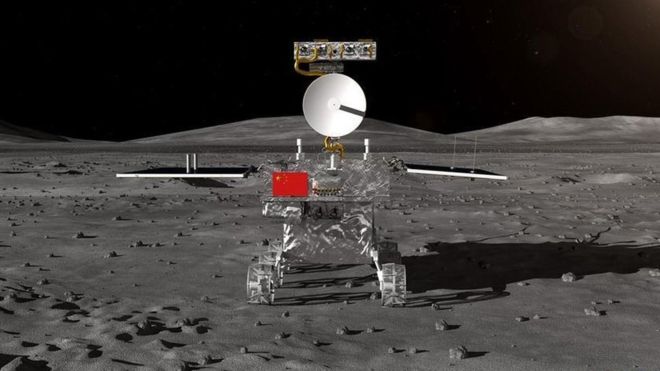Everyone, it seems, wants to go the moon now.
如今似乎人人都想到月亮上去。
In January, Chang’e-4, a Chinese robotic spacecraft including a small rover, became the first ever to land on the far side of the moon. India is aiming to launch Chandrayaan-2 this month, its first attempt to reach the lunar surface. Even a small Israeli nonprofit, SpaceIL, tried to send a small robotic lander there this year, but it crashed. In the coming decades, boots worn by visitors from these and other nations could add their prints to the lunar dust. The fascination with Earth’s celestial companion is not limited to nation-states. A bevy of companies has lined up in hopes of winning NASA contracts to deliver experiments and instruments to the moon.
1月,中國的嫦娥四號機器人探測器攜帶一臺小型巡視器歷史上首次在月球背面著陸。印度計劃本月發射“月船2號”(Chandrayaan-2),是該國首次嘗試到達月球表面。連以色列一家小型非營利性組織SpaceIL今年也嘗試發射了一個小型機器人著陸器到月球,但墜毀了。在未來幾十年里,包括前述這些在內的許多國家的到訪者,可能會在月球塵埃上留下他們的鞋印。對這個地球天體同伴的迷戀不僅僅限于民族國家。許多公司都已排隊等候希望獲得美國國家航空航天局的合同,以便向月球遞送實驗和儀器。
So why go back?
為何回歸登月計劃?
A primary impetus for a moon stampede now? The discovery that there is water there, especially ice deep within polar craters where the sun never shines. That is a potentially invaluable source of drinking water for future astronauts visiting the moon, but also for water that can be broken down into hydrogen and oxygen. The oxygen could provide breathable air; oxygen and hydrogen could also be used as rocket propellant. Thus, the moon, or a refueling station in orbit around the moon, could serve as a stop for spacecraft to refill their tanks before heading out into the solar system.
現在競相登月的主要動力何在?已經發現月球上有水,特別是太陽照射不到的極地隕坑深處有冰。對未來訪問月球的宇航員而言,這可能是寶貴的潛在飲用水源,但也可用來分解出氫氣和氧氣。氧氣可供呼吸;氧氣和氫氣還可用作火箭的推進燃料。因此,月球或月球軌道上的燃料補給站可作為航天器的停靠站,在深入太陽系前為油箱加油。

Making moon money
賺月亮錢
As these administrations wavered, entrepreneurs had begun brainstorming possible business ventures on the moon. In 2007, the X Prize Foundation announced a $20 million grand prize, bankrolled by Google, that would be awarded to the first private team that could put a robotic lander on the moon. But while no company could claim the jackpot, many have not given up on the moon as a business opportunity.
在政府搖擺不定的同時,企業家們開始集思廣益,考慮在月球上進行商業經營的可能性。2007年,“X獎”基金會宣布了一項由谷歌資助的2000萬美元大獎,將授予第一個能夠將機器人著陸器送上月球的私資團隊。雖然沒有一家公司能贏得頭獎,但許多公司并沒有放棄把登月變為商機。
The payoffs of the moon could include helium-3 mined from the lunar soil, potentially a fuel for future fusion reactors, although practical fusion reactors are still decades away. There could be an opening for companies that would ship the ashes of loved ones to the moon as a memorial. And some private companies could carry payloads for scientific research. For instance, the far side of the moon could be ideal for optical and radio telescopes because they would not face earthly interference there. With these potential businesses, the Lunar X Prize may turn out to be a success, even though there was no winner.
登月的回報可能包括從月球土壤中開采的氦-3,這可能是未來聚變反應堆的燃料,盡管實際的聚變反應堆還需要幾十年的時間才會出現。將親人骨灰運往月球作為一種悼念的公司可能會有機會。一些私資公司可以為科學研究攜帶載荷。例如,月球遠面可能是光學望遠鏡和射電望遠鏡的理想位置,因為那里不會受到地球的干擾。有了這些潛在的業務,就算沒有贏家,月球X獎也可能是個成功。











